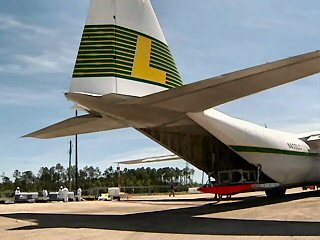
UPDATE at 9:35 MT, April 28
The Coast Guard will conduct a test burn today between 11 and 12 CT. The test will involve setting fire to some of the thickest oil in an area encircled by a 500-foot fireproof boom.
Four conditions have to be met for the oil burning operation:
- The layer of oil on the surface must be at least 2 mm thick; if there is not enough, it will not sustain a fire;
- The ignition device must be hot enough and must last long enough to keep the fire going;
- The oil to water ratio must be between 20% and 50%;
- The wind has to cooperate; too strong a wind is not acceptable.
Petty Officer Steve Lehmann of the Coast Guard said:
It’s not something we do very often, so we want to make sure we do it right. You need to herd it up and group it a certain way, and then there’s the whole lighting of it.
This will be a small step towards dealing with the oil slick that is the size of the state of Delaware.
===============
No doubt you have heard about the blown-up oil well in the Gulf of Mexico that is pouring 42,000 gallons of oil a day into the water. The Coast Guard is using tactics that would be (sort of) familiar to wildland firefighters.
1. They are planning to use prescribed fires to burn off some of the oil. The Coast Guard of course does not use the term “prescribed fire”, but they are considering corralling some of the oil in fire-proof booms, and then setting it on fire. In spite of the nasty stuff that will go up in the smoke, they figure this will be better than trying to clean up the oil after it hits the beaches. This could begin as early as Wednesday, and would only be done during the day.
 2. They are already using five aircraft to drop dispersants onto the oil slick, including helicopters, and two C-130A’s, which are operated by Marine Spill Response Corporation, an organization funded by the big oil companies for cleaning up oil spills. The C-130A’s can carry 5,000 gallons of dispersant to the oil spill, which is a 35-minute flight from Stennis International Airport near Bay St. Louis, Mississippi. When the aircraft arrive at the spill, they drop the dispersant at 150 mph and 75 feet above the ocean. The C-130A’s are flying nine flights a day to the spill from Stennis.
2. They are already using five aircraft to drop dispersants onto the oil slick, including helicopters, and two C-130A’s, which are operated by Marine Spill Response Corporation, an organization funded by the big oil companies for cleaning up oil spills. The C-130A’s can carry 5,000 gallons of dispersant to the oil spill, which is a 35-minute flight from Stennis International Airport near Bay St. Louis, Mississippi. When the aircraft arrive at the spill, they drop the dispersant at 150 mph and 75 feet above the ocean. The C-130A’s are flying nine flights a day to the spill from Stennis.
Below is a video about the dispersant flights. Click on the button in the lower-right corner to see it full-screen.
For you Incident Command System geeks, the incident is being run under a Unified Command, shared by the Coast Guard and the Minerals Management Service. The Coast Guard Incident Commander is Rear Adm. Mary Landry. As the lease operator of the drilling rig, the BP oil company is responsible for the spill.
After being dragged kicking and screaming into the ICS community in the early 1990’s, the Coast Guard now frequently hosts ICS traning and exercises, often taught by private contractors.

Thanks Bill, the worst is yet to come, I am very involved in this operation right now, and the Pacific West NPS All Hazard Team has been ordered for Gulf Islands NS. The burning was started last night, and is working, but it is a small start. Oil land fall in LA is expected by tomorrow.